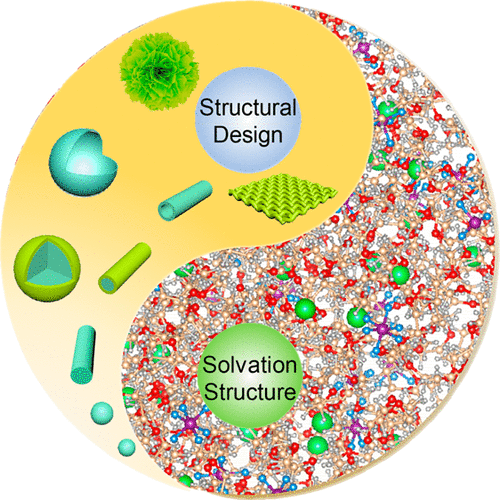当前位置:
X-MOL 学术
›
ACS Energy Lett.
›
论文详情
Our official English website, www.x-mol.net, welcomes your
feedback! (Note: you will need to create a separate account there.)
Electrolyte Engineering Enables High Stability and Capacity Alloying Anodes for Sodium and Potassium Ion Batteries
ACS Energy Letters ( IF 19.3 ) Pub Date : 2020-02-17 , DOI: 10.1021/acsenergylett.0c00148 Lin Zhou 1, 2 , Zhen Cao 3 , Wandi Wahyudi 3 , Jiao Zhang 1, 2 , Jang-Yeon Hwang 4 , Yong Cheng 1 , Limin Wang 1, 2 , Luigi Cavallo 3 , Thomas Anthopoulos 3 , Yang-Kook Sun 4 , Husam N. Alshareef 3 , Jun Ming 1, 2
ACS Energy Letters ( IF 19.3 ) Pub Date : 2020-02-17 , DOI: 10.1021/acsenergylett.0c00148 Lin Zhou 1, 2 , Zhen Cao 3 , Wandi Wahyudi 3 , Jiao Zhang 1, 2 , Jang-Yeon Hwang 4 , Yong Cheng 1 , Limin Wang 1, 2 , Luigi Cavallo 3 , Thomas Anthopoulos 3 , Yang-Kook Sun 4 , Husam N. Alshareef 3 , Jun Ming 1, 2
Affiliation

|
Development of sodium and potassium ion batteries with greater energy density is gaining great attention. Although recently proposed alloying anodes (e.g., Sn and Bi) demonstrate much higher capacity than classic carbon anodes, their severe capacity fading hinders their practical applications. The failure mechanism has traditionally been attributed to the large volumetric change and/or their fragile solid electrolyte interphase (SEI). However, herein we present a completely new concept and approach based on electrolyte engineering to stabilize alloying anodes. This approach results in unprecedented high capacity (>650 mAh g–1) and stability (>500 cycles) of alloying anodes by simply tuning the electrolyte compositions, without the need for nanostructural control and/or carbon modification. We confirm that the cation solvation structure, particularly the type and location of the anions in the electrolyte, plays a critical role in alloying anode stabilization. We further present a new anionic and alloying anode reaction model showing that the root cause of the capacity fading in these alloys is dictated by the properties of the anions and not only the volume change or fragile SEI effect. Our model elucidates the failure mechanism in alloying anodes and provides a new guideline for electrolyte design that stabilizes alloying anodes in emerging mobile ion batteries.
中文翻译:

电解质工程技术可为钠和钾离子电池提供高稳定性和高容量的合金阳极
具有更高能量密度的钠和钾离子电池的开发受到了广泛的关注。尽管最近提出的合金阳极(例如,Sn和Bi)显示出比经典碳阳极高得多的容量,但它们严重的容量衰减却阻碍了其实际应用。传统上,失效机理归因于大的体积变化和/或它们脆弱的固体电解质界面(SEI)。但是,在这里,我们提出了一种基于电解质工程的全新概念和方法来稳定合金阳极。这种方法可实现前所未有的高容量(> 650 mAh g –1通过简单地调整电解质组成,无需纳米结构控制和/或碳改性,就可以确保合金阳极的稳定性和稳定性(> 500个循环)。我们证实,阳离子溶剂化结构,特别是阴离子在电解质中的类型和位置,在合金化阳极稳定中起关键作用。我们进一步提出了一种新的阴离子和合金阳极反应模型,表明这些合金中容量衰减的根本原因不仅取决于体积变化或脆弱的SEI效应,还取决于阴离子的性质。我们的模型阐明了合金阳极中的失效机理,并为电解质设计提供了新的指导方针,以稳定新兴移动离子电池中合金阳极的稳定性。
更新日期:2020-02-17
中文翻译:

电解质工程技术可为钠和钾离子电池提供高稳定性和高容量的合金阳极
具有更高能量密度的钠和钾离子电池的开发受到了广泛的关注。尽管最近提出的合金阳极(例如,Sn和Bi)显示出比经典碳阳极高得多的容量,但它们严重的容量衰减却阻碍了其实际应用。传统上,失效机理归因于大的体积变化和/或它们脆弱的固体电解质界面(SEI)。但是,在这里,我们提出了一种基于电解质工程的全新概念和方法来稳定合金阳极。这种方法可实现前所未有的高容量(> 650 mAh g –1通过简单地调整电解质组成,无需纳米结构控制和/或碳改性,就可以确保合金阳极的稳定性和稳定性(> 500个循环)。我们证实,阳离子溶剂化结构,特别是阴离子在电解质中的类型和位置,在合金化阳极稳定中起关键作用。我们进一步提出了一种新的阴离子和合金阳极反应模型,表明这些合金中容量衰减的根本原因不仅取决于体积变化或脆弱的SEI效应,还取决于阴离子的性质。我们的模型阐明了合金阳极中的失效机理,并为电解质设计提供了新的指导方针,以稳定新兴移动离子电池中合金阳极的稳定性。











































 京公网安备 11010802027423号
京公网安备 11010802027423号